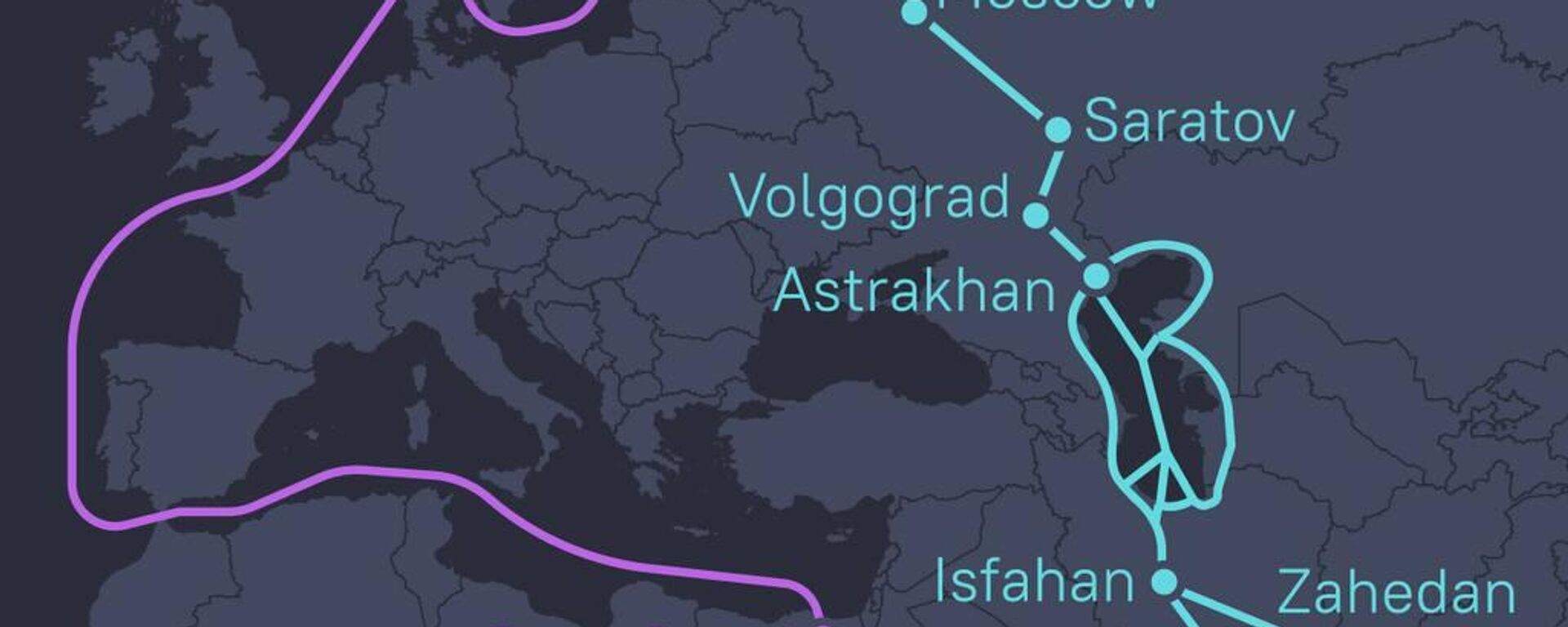https://sputniknews.in/20241231/north-south-corridor-belt-and-road-on-track-to-revolutionise-geo-economics-in-2025-8590478.html
North-South Corridor, Belt and Road On Track to Revolutionise Geo-Economics In 2025
North-South Corridor, Belt and Road On Track to Revolutionise Geo-Economics In 2025
Sputnik India
In 2025, the growing significance of the International North-South Transport Corridor (INSTC) and the Belt and Road Initiative (BRI) will play a pivotal role... 31.12.2024, Sputnik India
2024-12-31T11:02+0530
2024-12-31T11:02+0530
2024-12-31T11:02+0530
sputnik opinion
india
iran
russia
taliban
international north-south transport corridor (instc)
belt and road initiative (bri)
https://cdn1.img.sputniknews.in/img/07e7/0c/1c/6004616_0:107:2048:1259_1920x0_80_0_0_6e393c5f28022d96f3162e849f5eac1a.jpg
On December 21, the Russian and Azerbaijani governments signed cooperation agreements to enhance transit cargo transportation along the International North-South Transport Corridor, and improve railway infrastructure, according to Russian government readout."The railway to the port of Bandar Abbas will create economic conditions for intensive development of the entire corridor," Vitaly Savelyev, Russia's Deputy Prime Minister, said.Moscow and Tehran are expected to sign a comprehensive strategic partnership deal in the coming year, highlighting the growing interconnectivity of transit corridors within the Global South.The INSTC enhances connectivity between India and Russia via Iran, providing both nations with a strategic alternative to conventional Western-controlled trade routes. This initiative is poised to strengthen their economic cooperation in key areas such as energy, defence, and technology, professor Srinivasan Balakrishnan, Director of Strategic Engagements and Partnerships at the Indic Researchers Forum and National President of the Bharatiya Yuva Seva Sangh (BYSS), said in an interview with Sputnik India.However, the expansion of the Belt and Road Initiative in the region, while bolstering China's influence, will also compel India and Russia to strengthen their partnerships. This development will serve as a counterbalance to Western geopolitical strategies, he added.Iran could become an important transit hub for Indian goods, and both nations are expected to ramp up their cooperation in sectors like infrastructure, energy, and agriculture. With the lifting or easing of some sanctions in future scenarios, Indian investments in Iran’s oil and gas sectors could also see a boost, he added.The INSTC offers an alternative to traditional maritime routes, Khalid Taimur Akram, Executive Director of the Pakistan Research Center for a Community with Shared Future (PRCCSF), noted while speaking to Sputnik India.This corridor significantly reduces both costs and transit times for goods travelling between South Asia and Eurasia. Collectively, these corridors enhance economic ties among countries in the Global South, positioning the region as a crucial link in global trade while promoting regional cooperation and stability.Akram suggested that by 2025, significant changes in trade and economic partnerships are expected, building on the progress achieved in 2024. The China-Pakistan Economic Corridor (CPEC), as a flagship Belt and Road Initiative (BRI) project, will continue driving Pakistan's economic and development transformation, he added.The INSTC, a 7,200-kilometre multimodal route, was enthusiastically put forward by India to reduce transit time and transport costs between India and Europe.This initiative aims to cut transit time to just 20 days and lower costs by $2,500 for every 15 tonnes of freight, Burzine Waghmar, an expert from the Centre for Iranian Studies and the South Asia Institute at the School of Oriental and African Studies in London recalled in a conversation to Sputnik India.He noted that avoiding the traditional chokepoints, whether the Suez Canal or the Straits of Hormuz, not to mention the Pakistani overland barrier for Indian exports to Central Asia, factored into Indian strategic thinking. However, one of the shortest links between the Persian Gulf and Black Sea would have been covered by the Southern Armenia Railways which, since 2012, exists on paper only.He further argued that Chahbahar, unlike Bandar Abbas, is capable of accommodating vessels larger than 10,000 tonnes, therefore, its integration into the INSTC would have been ideal. However, Iran remains under sanctions, and in 2018, USA granted India only a temporary reprieve for engineering projects at Chahbahar. This included the construction of a rail link between Chahbahar and Zahedan, as well as the Delaram-Zaranj highway, known as Route 606, which India built to connect Afghanistan's Farah and Nimruz provinces.Iran would be uneasy about allowing Taliban 2.0 access to Chahbahar, something which they have expressed interest in recently, unless the Afghanistan government provided greater cooperation in releasing an official report long sought by Iran regarding the murder of its diplomats at Mazar-i Sharif consulate, August 1998, the pundit concluded.
https://sputniknews.in/20240830/rasht-astara-railway-crucial-to-enhancing-indias-trade-volume-8086858.html
india
iran
russia
Sputnik India
feedback.hindi@sputniknews.com
+74956456601
MIA „Rossiya Segodnya“
2024
Muhammad Sharif
https://cdn1.img.sputniknews.in/img/07e7/0b/05/5257054_0:0:443:444_100x100_80_0_0_b8bd2af32be62a6eecdb4a84c7fd978f.jpg
Muhammad Sharif
https://cdn1.img.sputniknews.in/img/07e7/0b/05/5257054_0:0:443:444_100x100_80_0_0_b8bd2af32be62a6eecdb4a84c7fd978f.jpg
News
en_IN
Sputnik India
feedback.hindi@sputniknews.com
+74956456601
MIA „Rossiya Segodnya“
Sputnik India
feedback.hindi@sputniknews.com
+74956456601
MIA „Rossiya Segodnya“
Muhammad Sharif
https://cdn1.img.sputniknews.in/img/07e7/0b/05/5257054_0:0:443:444_100x100_80_0_0_b8bd2af32be62a6eecdb4a84c7fd978f.jpg
india, iran, russia, taliban, international north-south transport corridor (instc), belt and road initiative (bri)
india, iran, russia, taliban, international north-south transport corridor (instc), belt and road initiative (bri)
North-South Corridor, Belt and Road On Track to Revolutionise Geo-Economics In 2025
In 2025, the growing significance of the International North-South Transport Corridor (INSTC) and the Belt and Road Initiative (BRI) will play a pivotal role in countering Western dominance in South Asia, experts have said.
On December 21, the Russian and Azerbaijani governments signed cooperation agreements to enhance transit cargo transportation along the International North-South Transport Corridor, and improve railway infrastructure, according to Russian government readout.
"The railway to the port of Bandar Abbas will create economic conditions for intensive development of the entire corridor," Vitaly Savelyev, Russia's Deputy Prime Minister, said.
Moscow and Tehran are expected to sign a comprehensive strategic partnership deal in the coming year, highlighting the growing interconnectivity of transit corridors within the
Global South. The INSTC enhances connectivity between India and Russia via Iran, providing both nations with a strategic alternative to conventional Western-controlled trade routes. This initiative is poised to strengthen their economic cooperation in key areas such as energy, defence, and technology, professor Srinivasan Balakrishnan, Director of Strategic Engagements and Partnerships at the Indic Researchers Forum and National President of the Bharatiya Yuva Seva Sangh (BYSS), said in an interview with Sputnik India.
However, the expansion of the Belt and Road Initiative in the region, while bolstering China's influence, will also compel India and Russia to strengthen their partnerships. This development will serve as a counterbalance to Western geopolitical strategies, he added.
“In 2025, trade and economic ties between India, Russia, and Iran are set to strengthen significantly, driven by the growth of the International North-South Transport Corridor (INSTC). This corridor will facilitate smoother trade flows, enhancing India’s access to Russian and Iranian markets while bypassing traditional Western routes,” Balakrishnan underlined.
Iran could become an important transit hub for Indian goods, and both nations are expected to ramp up their cooperation in sectors like infrastructure, energy, and agriculture. With the lifting or easing of some sanctions in future scenarios, Indian investments in Iran’s oil and gas sectors could also see a boost, he added.
The INSTC offers an alternative to traditional maritime routes, Khalid Taimur Akram, Executive Director of the Pakistan Research Center for a Community with Shared Future (PRCCSF), noted while speaking to Sputnik India.
This corridor significantly reduces both costs and transit times for goods travelling between South Asia and Eurasia. Collectively, these corridors enhance economic ties among countries in the Global South, positioning the region as a crucial link in global trade while promoting regional cooperation and stability.
Akram suggested that by 2025, significant changes in trade and economic partnerships are expected, building on the progress achieved in 2024. The
China-Pakistan Economic Corridor (CPEC), as a flagship Belt and Road Initiative (BRI) project, will continue driving Pakistan's economic and development transformation, he added.
“Trade volume through CPEC which surged from $4.8 billion in 2015 to $16 billion in 2023, is leading to further growth and development. The infrastructure and connectivity will enhance smoother trade between Pakistan, China, and Central Asian markets,” he further stated.
The INSTC, a 7,200-kilometre multimodal route, was enthusiastically put forward by India to reduce transit time and transport costs between India and Europe.
This initiative aims to cut transit time to just 20 days and lower costs by $2,500 for every 15 tonnes of freight, Burzine Waghmar, an expert from the Centre for Iranian Studies and the South Asia Institute at the School of Oriental and African Studies in London recalled in a conversation to Sputnik India.
He noted that avoiding the traditional chokepoints, whether the Suez Canal or the Straits of Hormuz, not to mention the Pakistani overland barrier for Indian exports to Central Asia, factored into Indian strategic thinking. However, one of the shortest links between the Persian Gulf and Black Sea would have been covered by the Southern Armenia Railways which, since 2012, exists on paper only.
“India, since 2015, has been engaged in developing and maintaining Shahid Beheshti Port, one of two, located at Chahbahar, which provides the closest maritime link between the Indian west coast and Iran for overland trade to Central Asia and relief supplies (wheat, medicines) to Afghanistan thus achieving its twin objectives of bypassing Pakistan as well as acquiring a counterweight to China's BRI-networked Gwadar port in neighboring Pakistan's insurgency-racked province,” Waghmar underlined.
He further argued that Chahbahar, unlike Bandar Abbas, is capable of accommodating vessels larger than 10,000 tonnes, therefore, its integration into the INSTC would have been ideal. However, Iran remains under sanctions, and in 2018, USA granted India only a temporary reprieve for engineering projects at Chahbahar. This included the construction of a rail link between Chahbahar and Zahedan, as well as the Delaram-Zaranj highway, known as Route 606, which India built to connect Afghanistan's Farah and Nimruz provinces.
Iran would be uneasy about allowing Taliban 2.0 access to Chahbahar, something which they have expressed interest in recently, unless the Afghanistan government provided greater cooperation in releasing an official report long sought by Iran regarding the murder of its diplomats at Mazar-i Sharif consulate, August 1998, the pundit concluded.



